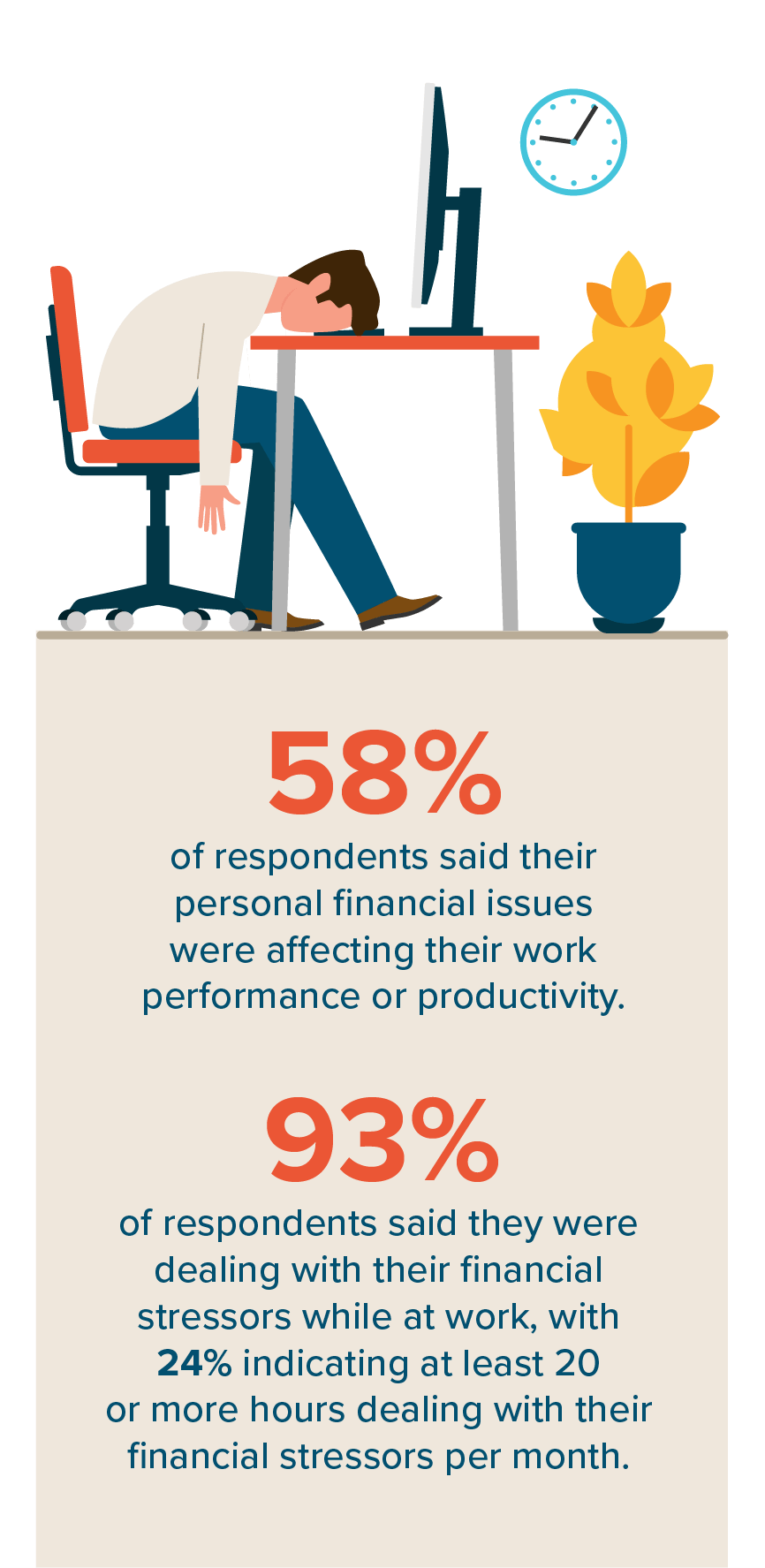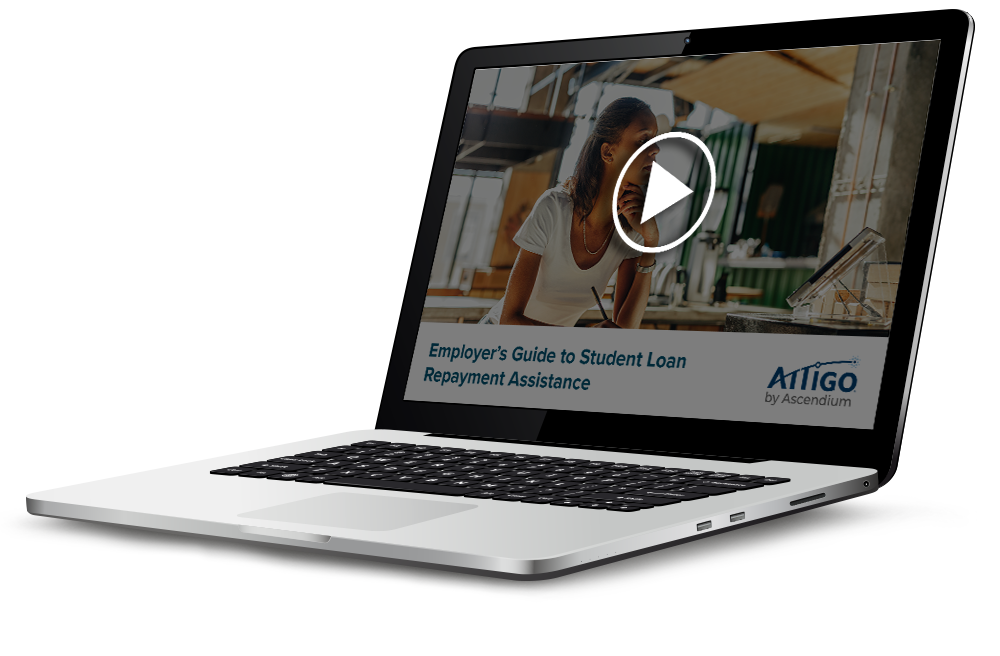How Student Loan Debt Affects Well-being

Recent studies and surveys from various organizations, such as the American Psychological Association, the Financial Health Network, and the National Institute of Health, have all conveyed that employee financial stress is increasing.
In their last Employee Financial Wellness survey, PricewaterhouseCoopers showed that 60% of full-time employees are stressed about their finances, which is higher than it was during the peak of the pandemic. And, among employees earning $100,000 or more per year, nearly half (47%) report experiencing financial stress.
Financial stressors are some of the most pervasive types of stressors because the inability to meet basic needs threatens a person’s financial stability — and other dimensions of well-being. Student loan debt is a financial stressor for millions of borrowers.
The stress of student loan debt has, and will continue to, become a major concern for workers as well as employers. The impact can lead to devastating, long-term consequences. But it doesn’t have to. Employers have an opportunity to help improve the well-being of their workers.
There are 42.7 million borrowers in the U.S. with an outstanding balance of nearly $1.7 trillion in federal student loans (Source: Education Data Initiative). Since 2000, the total number of people with student loan debt has more than doubled, and the amount owed has quadrupled, making it the fastest growing type of loan. It’s the second-largest type of consumer loan behind mortgages (Source: Peter G. Peterson Foundation).
In this guide, we’ll explain several important concepts.
- The student loan debt crisis in America and the burdening effect on the multigenerational workforce.
- How student loan debt intersects across dimensions of well-being.
- Solutions to address this national workplace issue.

(Source: Bankrate)
The Student Loan Debt Crisis
For many, student loan debt is a resource that provides the necessary financing for a college education. But it’s a double-edged sword: a resource and a liability. Without student loans, higher education would be inaccessible to many. But the student loan program is also complicated and confusing to borrowers.
The federal student loan program offers special benefits and borrower protections that aren’t available with other types of consumer loans. For example, multiple repayment options (some based on a borrower’s income), loan forgiveness and postponement options, and the ability to discharge loans in the event of disability or death.
Despite many attempts by loan servicers, schools, and third-party sources to help keep borrowers on track, some slip through the cracks. Default happens when a borrower has not made a payment for 270 days or more. Typically, the most vulnerable borrowers are disproportionately likely to default, as many of them have fewer resources to repay their loans. Due to the severe consequences of default — credit score damage, treasury offsets, wage garnishment, collection fees, etc. — borrowers with defaulted loans face barriers preventing financial health and security.

(Source: Education Data Initiative)
The Effects on the Multigenerational Workforce
The effect student loan debt has on the economy has been likened to a recession. It reduces consumer spending, business growth, and homeownership and is likely to have economic consequences for U.S. businesses, communities, and citizens.
Student loan debt spans multiple generations and burdens each one differently.
| Generation Z |
|
| Millennials |
|
| Generation X |
|
| Baby Boomers |
|

Student Loan Debt Intersects with Well-Being
Over the past few years, the focus on well-being, particularly mental and emotional health, has increased. One of the most significant influences of this increased attention is the psychological impact of the trauma created by the COVID-19 health crisis. During this time, stress levels were elevated, and people were experiencing anxiety, depression, and loneliness. More people were compelled to acknowledge the trauma and address their symptoms.
The dimensions of well-being have become increasingly relevant as we begin to look at our health more holistically. The concept of well-being is subjective, and each of us may have a different view of what it means.
Well-being is multi-dimensional with varying influential factors such as financial, emotional, and occupational to name a few. The dimensions of well-being are interconnected. A problem or deficit in one area can impact others. For example, if a person has persistent stressors affecting their occupational well-being, it’s likely to impact their home life or social well-being. Likewise, improving an area can have a positive ripple effect. It’s also common to have greater health in one or more areas than others. Overall well-being doesn’t require all dimensions to be balanced.
Impacts on Financial, Emotional, and Mental Well-Being
The psychology of money isn’t just about dollars and cents. It’s deeply influenced by our emotions, beliefs, values, and other factors. Money triggers our feelings and emotions. For instance, fear is a primal emotion that is triggered when we face a threat. If a person’s student loan debt threatens their ability to meet their basic living expenses, it’s likely to elicit fear. Other common emotions associated with student loan debt are shame, guilt, sadness, helplessness, and anger.
Research shows that a person burdened with student loan debt may go through an emotional path like the stages of grief.
- Denial that the debt is an issue or that their loans exist.
- Anger for not having the money to pay.
- Bargaining and thinking like, “If only I had looked for more scholarships, I wouldn’t have this debt.”
- Depression and a feeling of defeat.
That brings us to the dimension of mental well-being. Last year, a virtual learning platform company released a national study on the financial and mental costs of higher education issues (Source: Elvtr). The study found that:
- Over half (54%) of student loan borrowers have faced mental health issues directly related to their debt.
- 56% report feeling anxiety due to debt.
- 32% had depression.
Another similar study revealed alarming rates of suicidal ideation among borrowers, with 1 in 14 experiencing such thoughts due to financial stress from student loans (Source: Student Loan Planner).
Impacts on Financial, Emotional, and Mental Well-Being
Chronic stress is the reaction to prolonged and constant stressors. The body’s “fight or flight” response occurs when a stressor is present, and it returns to normal when it perceives the stressor is gone or no longer a threat. However, the fight or flight response stays activated if the stressor remains. Borrowers may experience chronic stress if the burden of their debt persists over some time. According to a study by the American Journal of Preventative Medicine, student loan debt is linked to increased risks of cardiovascular disease and hypertension. The side effects may also impact occupational well-being.
According to a national Ascendium survey:


We know that life is about trade-offs. Sometimes we must make sacrifices to obtain what we want later. But student loan debt prevents many borrowers from pursing important and key milestones, such as getting married, starting a family, or saving for retirement. Delayed milestones can diminish confidence, strain relationships, and threaten financial security.
Solutions to Enhance Employee Well-Being Are a Top Priority
Recently, support for employee well-being has shifted dramatically. More organizations are realizing that prioritizing employee’s health and well-being is a necessity. Most people want to work at an organization that values them as a whole person. And when employees feel their organization cares about their well-being, it yields tremendous benefits, such as higher engagement, retention, employee satisfaction, and productivity.
“Last year, NASDAQ reported that 45% of workers consider student loan repayment assistance the single most important benefit, ranking it higher than additional retirement and health care contributions. ”
Student Loan Repayment Assistance

Student loan repayment assistance is an employee benefit that enables employers to make payments toward their employees’ student loans or make matching contributions to the employees’ retirement accounts when they make a student loan payment.
Employer Contribution (a.k.a. Student Loan Paydown):
A student loan repayment assistance employee benefit where an employer makes a contribution to employees’ student loans.
Employers can make tax-free payment contributions of any amount up to $5,250 per year, per employee. They can reimburse the employee like is done with tuition reimbursement, but most organizations make payments directly to the employee’s student loan lender or servicer. A $5,250 cap is the combined annual limit for education assistance payments — whether through tuition reimbursement or student loan repayment — and must be included as part of an Education Assistance Program.
Matching Retirement Contribution:
A student loan repayment assistance employee benefit where the employer makes a matching contribution to employees’ retirement accounts when employees make a student loan payment.
The SECURE 2.0 Act gives employers the option to make a matching contribution to the employee’s retirement plan, even if the employee is not actively, or fully, contributing to it. It permits an employer to make matching contributions under a 401(k) plan, 403(b) plan, or SIMPLE IRA with respect to qualified student loan payments.
SECURE 2.0 removes the dilemma that many workers face — they no longer must choose between saving for retirement or paying student loan debt.
Comprehensive Student Loan Support
In this highly competitive job market, Ascendium’s student loan repayment support is a great benefit to offer.
- Personalized 1:1 student loan counseling.
- Online financial education.
- A platform that allows employers to make contributions to employees’ student loans AND Make matching contributions to employees’ retirement accounts when they make a student loan payment.
Ready to Learn More?

The competition for top talent is fierce. A student loan paydown benefit helps you stand out.
Introducing this benefit is easier than you might think — our employer’s guide can help.

Student Loan Debt by the Numbers — for Employers
Use our interactive map to view student loan debt information by state.